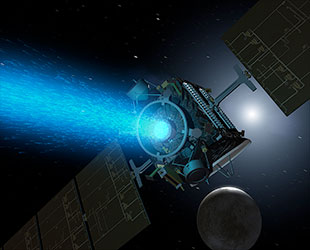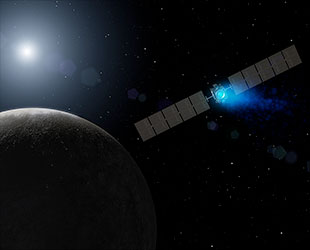March 6, 2015 — NASA's Dawn probe has entered orbit... again.
The first robotic probe to circle two different extraterrestrial worlds, Dawn slipped into orbit around Ceres, the smallest known dwarf planet and largest object in the asteroid belt, on Friday (March 6).
"Confirmed: I am in orbit around Ceres," Dawn's managers announced using the mission's Twitter account.
The spacecraft was 38,000 miles (61,000 kilometers) from Ceres when it was captured by the dwarf planet's gravity at about 7:39 a.m. EST (1239 GMT).
Mission controllers at NASA's Jet Propulsion Laboratory (JPL) in Pasadena, California received a signal from the spacecraft at 8:36 a.m. EST (1336 GMT) that Dawn was healthy and thrusting with its solar electric ion engine, the indicator Dawn had entered orbit as planned.

Ceres rotates in this sped-up movie comprised of images taken by Dawn during its approach. (NASA/JPL/UCLA/MPS/DLR/IDA) |
"Since its discovery [by Father Giuseppe Piazzi] in 1801, Ceres was known as a planet, then an asteroid and later a dwarf planet," Marc Rayman, Dawn's chief engineer and mission director at JPL, said in a statement. "Now, after a journey of 3.1 billion miles (4.9 billion km) and 7.5 years, Dawn calls Ceres home."
Dawn of the solar system
Launched in 2007, Dawn's historic arrival at Ceres came one and a half years after it left the orbit of Vesta, another giant asteroid that it circled and observed for 14 months. Unlike Ceres, Vesta formed earlier and is a very dry body. Ceres, in contrast, is thought to be about 25 percent water by mass, a quantity roughly equivalent to the fresh water on Earth.
Vesta is about 330 miles (530 kilometers) wide. Ceres has about a 590 mile (950 km) diameter.
"These bodies are samples of the building blocks that have formed Venus, Earth and Mars," Carol Raymond, the mission's deputy project scientist at JPL, said. "Vesta-like bodies are believed to have contributed heavily to the core of our planet, and Ceres-like bodies may have provided our water."

Mosaic synthesizing some of the best views NASA's Dawn had of the giant asteroid Vesta. (NASA/JPL/UCLA/MPS/DLR/IDA) |
Dawn began its final approach toward Ceres in December. The probe has taken several optical navigation images and made two rotation characterizations, allowing Ceres to be observed through its full nine-hour rotation. Since Jan. 25, Dawn has been delivering the highest-quality images of Ceres ever captured, revealing numerous craters and unusual bright spots.
The most recent images, taken on March 1, show Ceres as a crescent, mostly in shadow because the spacecraft's trajectory put it on a side of Ceres that faces away from the sun until mid-April. When Dawn emerges from Ceres' dark side, it will deliver ever-sharper images as it spirals to lower orbits around the planet.
"Studying Ceres allows us to do historical research in space, opening a window into the earliest chapter in the history of our solar system," said Jim Green, the director of NASA's Planetary Science Division at its headquarters in Washington. "Data returned from Dawn could contribute significant breakthroughs in our understanding of how the solar system formed."
Dawn will spend the next six weeks spiraling down to its initial science orbit, arriving there on April 23. The probe will then begin measuring Ceres from an altitude of 8,400 miles (13,500 km). Dawn will study the dwarf planet from a series of increasingly closer orbits until the mission ends in June 2016.
Pushing Dawn forward
The $473 million Dawn mission is NASA's first scientific probe to be powered by solar electric ion engines, which accelerates xenon ions out the back of the spacecraft. Though ion engines generate only a tiny amount of thrust, they are about 10 times more efficient than the traditional chemical systems. So Dawn's engines can keep firing for weeks, months and years, accelerating it to tremendous speeds.

Artist's concept shows NASA's Dawn arriving at the dwarf planet Ceres. The xenon ions glow with blue light. (NASA/JPL) |
"With the 1000 lbs. of xenon propellant that was loaded on board, Dawn has already accomplished more than 24,000 mph of velocity change," Dawn's project manager Robert Mase of JPL said during a news conference on Monday. "To put that in context, that's more than it takes to get a vehicle from Earth's surface up to the International Space Station."
Orbital ATK designed and built Dawn, which measures 65 feet long (20 meters) and weighed almost 2,700 lbs. (1225 kg) at launch.
"More than a decade ago, we committed to developing this spacecraft in an innovative way to assure that it was reliable and affordable," Frank Culbertson, the president of Orbital ATK's Space Systems Group stated on Friday. "To see Dawn enter into this exciting science phase in fully functional status after seven-and-a-half years and several billion miles of deep-space journey is a testament to the design and workmanship skills of the JPL and Orbital ATK team."
Sizing up dwarf planets

Artist's concept showing Dawn's arrival at Ceres. (NASA/JPL) |
Dawn's arrival at Ceres comes just four months ahead of another highly-anticipated dwarf-planet encounter. On July 14, NASA's New Horizons spacecraft will fly by the Pluto system, providing the first good look at that faraway dwarf planet and its five known moons.
Pluto, however, formed differently at a different time and out of different materials than Ceres, so the data returned by Dawn and New Horizons will likely not paint a unifying picture of just what it means to be a dwarf planet. Overall, Dawn will characterize Ceres in detail, determining what it is made of and mapping out its surface.
"We've much to do over the next year and a half, but we are now on station with ample reserves, and a robust plan to obtain our science objectives," Chris Russell, Dawn's principal investigator at UCLA, said.
Michael Wall with Space.com contributed to this article.
